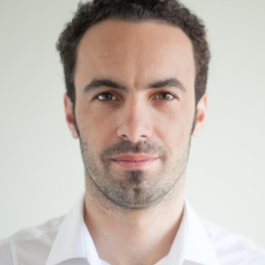Launching a new product is like climbing a mountain. The journey is thrilling, challenging and, ultimately, rewarding.
Leaders at these four featured companies have scaled their summits, unveiling exciting new products and features that are revolutionizing their respective tech spaces. From inception through launch, these pros oversaw ambitious projects that leverage the power of AI and automation tools to help people communicate better, unlock their creativity, navigate their financial futures and more.
Their product journeys, however, didn’t end once the offerings became available to customers. Rather, the leaders remain committed to ensuring the best client experience possible, reiterating and improving upon their solutions and services.
Reflecting on the twists and turns of their path to innovation, these featured leaders — from Grammarly, Roblox, Human Interest and Mixbook — connected with Built In San Francisco to share helpful lessons learned for fellow product professionals.
Grammarly runs an AI-powered writing assistant that helps people connect and communicate.
Tell us about a recent product your team launched.
In April 2023, Grammarly announced the beta release of GrammarlyGO, a communication assistant powered by generative AI. This tool helps users with ideation, composition, thoughtful replies and more. It’s a significant development for our individual and enterprise customers, as it will improve communication effectiveness in a way that suits our customers’ voices and audiences.
For our customers, GrammarlyGO builds on what we’ve been doing for years — helping people communicate more effectively by leveraging the latest technologies — and scales it throughout the entire communication journey. If previously our value skewed toward editing and polishing users’ writing, GrammarlyGO helps them ideate what they want to write, shape those ideas into a first draft and ultimately communicate their message efficiently and effectively.
This allows us to support communication more significantly than ever before, driving the value we create for individuals and enterprises, which leads to our product offerings becoming must-haves for users.
GrammarlyGO builds on what we’ve been doing for years and scales it throughout the entire communication journey.”
What was the biggest challenge your team faced while developing this new product, and how did you overcome it?
We faced a few challenges in the process of developing GrammarlyGO. We developed a new product on an aggressive timeline within a mature organization, which required adjustments on multiple levels. We had to reallocate resources and prioritize a brand-new product without proven success or revenue over more mature product offerings that already contribute significantly to the success of our business.
Additionally, we had to adjust our processes and team to operate lightly and focus on the deliverable, not on the process. This required us to take larger risks and operate with our intuition when we didn’t have data.
Building a product based on a brand-new technology that creates new user experience paradigms, addresses broader aspects of communication and delivers value is no small feat. We had to apply a “beginner’s mind” approach and acknowledge that we would not deliver a perfect product on the first attempt.
Instead, we built two internal prototypes that were throwaways. Their purpose was to help the team and broader Grammarly organization test our product and learn how it should work. The third prototype was the one we refined into GrammarlyGO and launched to our users.
What have you enjoyed most about working on this product?
Working on a brand-new product for Grammarly felt much like it did 10 years ago when we were a small startup. The difference now is our scale. While our GrammarlyGO team was small and scrappy, we had to scale to support the 30 million people and 50,000 teams that use our product daily, which created a new and fun challenge.
We operated with a small, tightly-aligned group of people where everyone was ready to wear multiple hats and do anything necessary for success. It allowed our team members to flex their skills in areas outside their typical scopes. It was inspiring to work with such a dedicated and skilled team to build something completely from scratch.
I also enjoyed learning how we can create new layers of value for our customers while leveraging cutting-edge technology. Seeing how users employ our product and how excited they are to be able to do something that previously wasn’t possible is incredibly energizing.
Roblox is an online global platform that allows users to connect and express themselves in immersive 3D experiences.
Tell us about a recent product your team launched.
In March, we launched two generative AI features: Code Assist and Material Generator. The goal for Code Assist is to help experienced scripters code smarter and faster, making scripting more accessible for everyone. Material Generator enables anyone to create a material to bring their vision to life in seconds. Together, these features enable our creator community to be more productive by giving them the tools to make content straight from their imagination.
After launching these two new tools, we are excited to see higher accessibility for our developers, as this ties directly to our team’s mission of enabling the creation of anything, anywhere, by anyone. By constantly investing in new tools and services, we enable our creator community to do things we never could have imagined.
These features enable our creator community to make content straight from their imagination.”
What was the biggest challenge your team faced while developing this new product, and how did you overcome it?
Our first key challenge was getting our underlying AI technology to the next level of quality and reliability. Then, we had to reimagine the user interface and user experience. These generative AI capabilities are very new to the world and sometimes require a reinvention of the user experience to harness the most value. We did a lot of user testing and had a soft launch of the features to get real-world insights and tune them accordingly.
What have you enjoyed most about working on this product?
These product features were and are at the forefront of what is possible today using AI. It was really fun to break new ground, see our creators experiment with new workflows and get really inspired by them. We are also very excited to bring these features at scale to players — not just our creators — in the future.
HR tech company Human Interest offers affordable 401(k) retirement plans to all businesses, no matter their size.
Tell us about a recent product that your team launched.
We build incredibly complex products. Bringing transparency to our customers and helping them navigate what can otherwise be significant pain points are really important to our team.
That’s why, in June, we launched a customer-facing compliance dashboard. This dashboard will afford our customers an unprecedented view into the complex, annual, IRS-required process that all 401(k) plans go through. Customers will be able to view preliminary and completed results.
In addition to transparency for our customers, the compliance dashboard automates a number of previously manual operations tasks. We are in the first phase of the release, but ultimately, if we continue to build to all our automation goals, 40 percent of our plans will experience end-to-end automation. In terms of time savings, we expect to save our team 30 to 60 minutes per plan. Automation is key for our strategy because it helps us pass on savings to our customers.
Bringing transparency to our customers and helping them navigate significant pain points are really important to our team.”
What was the biggest challenge that your team faced while developing this new product, and how did you overcome it?
I’d say the rollout was by far the biggest challenge. This was my first external-facing product release of this scale. So many of our customers are running the first 401(k) their business has ever had, and they often know compliance testing comes with a lot of work, a lot at stake and a lot of confusion. We knew clear customer communication was going to be paramount.
Communications needed to explain not only how to maneuver through the dashboard, but also the “why” behind the tool in a way that would be digestible to the average person. Fortunately, Human Interest has a strong culture of collaboration, and we were able to partner with our internal enablement and sales teams to craft clear messaging for our customers. I was able to work with cross-functional leaders and teammates to build a product we felt proud about shipping.
Alignment on launch timelines was another challenge. With so many moving parts and multiple teams involved, we relied heavily on our project management tools, regular syncs and strong working relationships. We ended up pushing the launch, but the decision aligned with our goal of bringing a best-in-class product to our customers.
What have you enjoyed most about working on this product?
The compliance dashboard was always going to end up on our roadmap, but given the complexities, it needed to be tackled at the right stage of the business. Helping bring a long-desired product from concept to launch was incredibly difficult but also very exciting. Each milestone that brought us closer to the finish line felt like a victory.
I was motivated by the desire to remove the proverbial black box around compliance testing and allow customers to truly understand what happens behind the scenes. That knowledge and understanding have the power to directly impact how someone feels about their retirement savings and plan.
Mixbook’s platform helps people design creative photo books, redefining how they experience their memories.
Tell us about a recent product your team launched.
We recently made a significant upgrade to our mobile app, version 2.1, which launched in May. The update is packed with multiple enhancements, but the standout addition has to be the Memory Lane feature. This feature simplifies the process of creating a new photo book, making it nearly effortless for our users.
Making a photo book can be a fun, creative task, but we’ve found that it can also be time-consuming. What we aimed to do with the Memory Lane feature is streamline the process. Using artificial intelligence, this feature scans the photos on your iPhone, grouping them into distinct memories and even suggesting the best photos from each set. The app also uses AI to lay out the photo book, leaving only small amendments or finishing touches.
Of course, no AI is perfect, so you can still tweak things as you see fit, but this process is far less time-consuming than going through each photo individually.
Since the launch, we’ve found that customers using this feature are able to significantly reduce the time it takes to create a photo book, enabling them to focus more on adding personal touches rather than spending so much time on the photo selection or book setup.
Memory Lane reduces the time it takes to create a photo book, enabling customers to focus on adding personal touches.”
What was the biggest challenge your team faced while developing this new product, and how did you overcome it?
One of our biggest challenges primarily stemmed from the extensive use of machine learning. We were able to use pre-existing trained models in some instances, but there were cases where we had to train models ourselves. Training a machine learning model can be quite complex, not just due to the massive volume of labeled data required for training, but also because of the need to strike a delicate balance.
Adding more data can often enhance the accuracy of the model, but it can also introduce noise, which may end up negatively impacting the performance. Essentially, the more data you feed into the system, the higher the chances of disrupting the balance and swaying the output unpredictably. Additionally, the number of output dimensions expected from the model can significantly influence this balance.
Navigating these complexities required a tightly organized team, and it called for seamless collaboration between our engineering, design and product teams. This allowed us to swiftly iterate and validate our models.
Of course, as with all AI, there is always room for improvement, but this is a really good first version that is a solid foundation on which we can build in the future.
What have you enjoyed most about working on this product, and why?
What I’ve loved most about this project is working at the intersection of technology and creativity. Using AI and machine learning tools is exciting, but transforming our user experience with tangible results is incredible. This technology enhances our customers’ creativity when making a photo book.
The amalgamation of technology and creativity is at the core of this project. We’ll continue to invest in it, empowering people to be creative and connect deeply with the ones they love.
The Mixbook team is passionate and talented. Working with the team from concept to realization has been a pleasure. Each team member’s dedication and expertise have shaped the final product. Ideas and feedback came from all areas of the business, contributing to the product’s existence.
Seeing that our efforts have reduced the time customers spend making photo books with Memory Lane — thereby freeing them to focus on creative expression rather than grappling with technical setup — has been icing on the cake. As a product manager, you have to accept that many experimental features may not have the impact that you expect, so it’s great to see that we’re on the right path.













